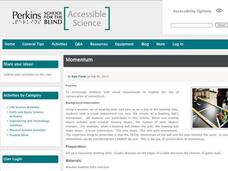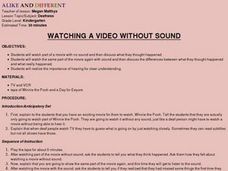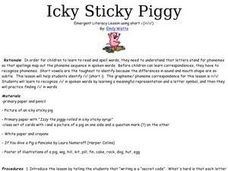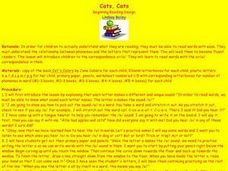Florida Center for Reading Research
Phonics: Onset and Rime, Word-Roll-A-Rama
Learners roll two die; die one contains various onsets, and die two contains different rimes. They write down the onset and rime pair they get, then blend and read their word.
August House
The Archer and the Sun
Reinforce reading comprehension with a instructional activity about The Archer and the Sun, a Chinese folktale. Kids learn some background information about Chinese culture before reading the story, and answer literacy...
Perkins School for the Blind
Momentum
The laws of momentum can lead to fun! Learners with visual impairments use bowling pins and a bowling ball to model the law of conservation of momentum. They take turns bowling with differing degrees of force to explore how energy is...
Federal Reserve Bank
What Really Caused the Great Depression?
Falling wages. Rising unemployment. Falling prices. Sound familiar? Young economists look at the role the US banking system had in causing the Great Depression.
Mobile Education Store
StoryBuilder for iPad
Invite your kids to tell all sorts of stories with this interactive app. Learners view images and record their own voices as as they create short narratives to go along with the images. The app provides plenty of...
Super Teacher Worksheets
The Closet Creature
Kelly Hashway's "The Closet Creature" gives primary graders an opportunity to demonstrate their reading comprehension skills as they respond to the prompts on four different reading worksheets.
E Reading Worksheets
Tone Worksheet 3
The interpretation of a poem often lies in the mind of its reader, especially when reading the tone. Focus on author's word choice, middle schoolers read four different poems and briefly state a perceived tone for each, along with the...
National Wildlife Federation
An Energy Mix: Renewable and Nonrenewable Resources
What did the windmill say about renewable energy? I'm a BIG fan! Lesson three in the series of 12 has classes discuss potential and kinetic energy and then, in pairs, they complete a web quest over the different types of energy...
Savvas Learning
Let's Get Moving
Scholars examine, cut, paste, and sort 12 images featuring different types of movement in order to show what they know about energy—potential and kinetic.
Anti-Defamation League
The Gender Wage Gap
"Equal pay for equal work!" may sound logical but it is not the reality. High schoolers begin a study of the gender wage gap with an activity that asks them to position themselves along a line that indicates whether they strongly agree...
Curated OER
Curricular Correlations
First graders listen to prerecorded sounds and put them into categories. They discus the sounds that would be heard outdoors, and indoors. They go outside for a few minutes and take a "hearing walk." Then they come inside and close their...
Curated OER
Lend Me Your Ear
Students engage in a lesson to investigate some of the properties of sound. They create sounds and listen to the vibrations that are made while listing all the sounds that are heard. This is done while the eyes are closed to strengthen...
Curated OER
Energy Forms
Young scholars explore energy by participating in a science lab in class. In this energy form lesson, students define the different types of energy such as light, mechanical and sound while examining energy measuring tools in class....
Curated OER
Watching a Video Without Sound
Students watch a video with no sound and discuss what they thought happened, then they watch the same section of video again with sound and compare what they thought happened with actual events. They explore life as a deaf person.
Curated OER
Pen Pals
Students discuss the sounds that different animals make. Then they play a listening game, using the animal sounds they've discussed.
Curated OER
The "B" Box
Students complete a variety of activities related to the letter B and the /b/ sound. As a class they recite a tongue twister, and identify objects from a box that have the /b/ sound in their name. Students also listen to the story...
Curated OER
Icky Sticky Piggy
Students examine the letter 'i' and the short /i/ sound. Through instruction and modeling they explore how to make the short /i/ sound, how the letter 'i' is written, etc. They recite tongue twisters and read stories and pick out words...
Curated OER
Cats, Cats
Learners complete a variety of activities related to the short /a/ sound. As a class they recite a tongue twister, then trace and write the letter A. Students then spell different words containing the short /a/ sound, listen to the book...
Curated OER
"Land of 1,000 Dances!"
Third graders distinguish between changes in pitch. They interpret and analyze different pitches being sounded at the same time. Students recognize and analyze a different style from a different ensemble. They listen to different melodies.
Curated OER
Good Vibrations
Students demonstrate sound waves and make changes in the waves
resulting in changes in pitch. Students associate changes in pitch in various "musical instruments"with size and shape and the sound waves they produce.
Curated OER
Icky Sticky
First graders the /i/ sound by practicing the way the mouth moves while making the sound while saying "icky, sticky." They write the letter "i" using both upper and lower case letters, make words using letterboxes, and write about a...
Curated OER
Objects Vibrate
Learners strike a tuning fork and dip it in water. They sprinkle cereal flakes on a drum, than tap the top of the drum. Students stretch a rubber band between two fingers and pluck it; stretch the elastic farther and pluck it again. Then...
Curated OER
Bravo!!
Second graders study and experiment with rhythm and sound. In pairs, they practice reading and performing simple melodies from sheet music. Individually, they choose one piece to perform for the class.
Curated OER
What doe the doctor say?
Students must explore the phoneme awareness. They must decode many different correspondences. Students explore the o sound by illustrating the concept using memorable tools used in by showing the o sound in spoken and written words.























